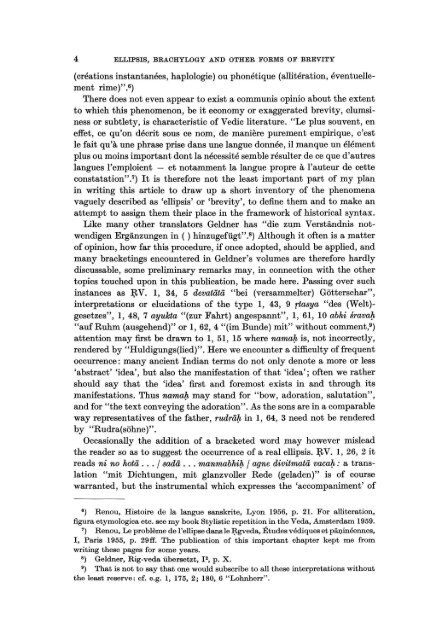Ellipsis, brachylogy and other forms of brevity in speech in ... - DWC
Ellipsis, brachylogy and other forms of brevity in speech in ... - DWC
Ellipsis, brachylogy and other forms of brevity in speech in ... - DWC
Create successful ePaper yourself
Turn your PDF publications into a flip-book with our unique Google optimized e-Paper software.
4 ELLIPSIS, BRACHYLOGY AND OTHER FORMS OF BREVITY<br />
(créations <strong>in</strong>stantanées, haplologie) ou phonétique (allitération, éventuellement<br />
rime)".6)<br />
There does not even appear to exist a communis op<strong>in</strong>io about the extent<br />
to which this phenomenon, be it economy or exaggerated <strong>brevity</strong>, clums<strong>in</strong>ess<br />
or subtlety, is characteristic <strong>of</strong> Vedic literature. "Le plus souvent, en<br />
effet, ce qu'on décrit sous ce nom, de manière purement empirique, c'est<br />
Ie fait qu'à une phrase prise dans une langue donnée, il manque un élément<br />
plus ou mo<strong>in</strong>s important dont la nécessité semble résulter de ce que d'autres<br />
langues l'emploient - et notamment la langue propre à l'auteur de cette<br />
constatation".7) It is therefore not the least important part <strong>of</strong> my plan<br />
<strong>in</strong> writ<strong>in</strong>g this article to draw up a short <strong>in</strong>ventory <strong>of</strong> the phenomena<br />
vaguely described as 'ellipsis' or '<strong>brevity</strong>', to det<strong>in</strong>e them <strong>and</strong> to make an<br />
attempt to assign them their place <strong>in</strong> the framework <strong>of</strong> historical syntax.<br />
Like many <strong>other</strong> translators Geldner has "die zum Verständnis notwendigen<br />
Ergänzungen <strong>in</strong> ( ) h<strong>in</strong>zugefügt".8) Although it <strong>of</strong> ten is a matter<br />
<strong>of</strong> op<strong>in</strong>ion, how far this procedure, if once adopted, should be applied, <strong>and</strong><br />
many bracket<strong>in</strong>gs encountered <strong>in</strong> Geldner's volumes are therefore hardly<br />
discussable, some prelim<strong>in</strong>ary remarks may, <strong>in</strong> connection with the <strong>other</strong><br />
topics touched upon <strong>in</strong> this publication, be made here. Pass<strong>in</strong>g over such<br />
<strong>in</strong>stances as :!;tV. 1, 34, 5 devatata "bei (versammelter) Götterschar",<br />
<strong>in</strong>terpretations or elucidations <strong>of</strong> the type 1, 43, 9 rtasya "des (Welt)gesetzes",<br />
1, 48, 7 ayukta "(zur Fahrt) angespannt", 1, 61, 10 abhi srava];,<br />
"auf Ruhm (ausgehend)" or 1, 62, 4 "(im Bunde) mit" without comment,9)<br />
attention may fust be drawn to 1, 51, 15 where nama];, is, not <strong>in</strong>correctly,<br />
rendered by "Huldigungs(lied)" . Here we encounter a difficulty <strong>of</strong> frequent<br />
occurrence: many ancient Indian terms do not only denote a more or less<br />
'abstract' 'idea', but also the manifestation <strong>of</strong> that 'idea'; <strong>of</strong> ten we rather<br />
should say that the 'idea' fust <strong>and</strong> foremost exists <strong>in</strong> <strong>and</strong> through its<br />
manifestations. Thus nama];, may st<strong>and</strong> for "bow, adoration, salutation",<br />
<strong>and</strong> for "the text convey<strong>in</strong>g the adoration". As the sons are <strong>in</strong> a comparable<br />
way representatives <strong>of</strong> the father, rudra];, <strong>in</strong> 1, 64, 3 need not be rendered<br />
by "Rudra(söhne)".<br />
Occasionally the addition <strong>of</strong> a bracketed word may however mislead<br />
the reader so as to suggest the occurrence <strong>of</strong> a real ellipsis. :!;tV. 1, 26, 2 it<br />
reads ni no hota ... / sada ... manmabhi];, / agne divitmata vaca];,: a translation<br />
"mit Dichtungen, mit glanzvoller Rede (geladen)" is <strong>of</strong> course<br />
warranted, but the <strong>in</strong>strumental which expresses the 'accompaniment' <strong>of</strong><br />
6) Renou, Histoire de la langue sanskrite, Lyon 1956, p. 21. For alliteration,<br />
figura etymologica etc. see my book Stylistic repetition <strong>in</strong> the Veda, Amsterdam 1959.<br />
7) Renou, Le problème de l'ellipse dans Ie J;tgveda, Études védiques et pät;l<strong>in</strong>éennes,<br />
!, Paris 1955, p . 29ff. The publication <strong>of</strong> this important chapter kept me from<br />
writ<strong>in</strong>g these pages for some years.<br />
8) Geldner, Rig-veda übersetzt, 12, p . X.<br />
9) That is not to say that one would subscribe to all these <strong>in</strong>terpretations without<br />
the least reserve: cf. e.g. 1, 175,2; 180,6 "Lohnherr".

















